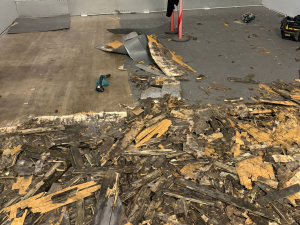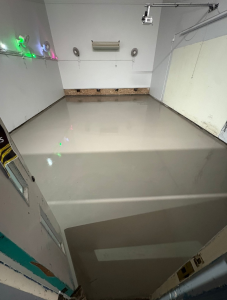Introduction
When flooring in a commercial space fails, especially unexpectedly, it can bring a business to a halt. This was the situation at a local gym that suffered flood damage. What started as a burst pipe quickly escalated into a full-scale flooring replacement project. This post documents the necessary steps taken to remove the damaged flooring, treat the subfloor, and install a new safety floor suitable for a busy gym environment.
The Flood and Initial Damage
The flooding occurred overnight, with water spreading across the main gym area. By the time staff arrived the following morning, the damage was already well underway. The existing vinyl flooring had started to lift, and the trapped water beneath it had already penetrated the subfloor.
Once an initial inspection was carried out, it became clear that a simple surface clean-up would not suffice. The water had been sitting long enough that the dampness had begun to compromise the screed, and patches of mould were already appearing. Not dealing with this properly would have meant structural issues, hygiene concerns, and future flooring failures.
Stripping Back the Floor
The first phase involved completely removing the existing vinyl covering. This allowed access to assess the condition of the screed below. Damaged sections of screed were cut out and removed as well. This was essential, as laying new flooring on top of compromised material would only mask underlying issues temporarily.
The exposed area was then inspected for any further signs of mould, moisture entrapment, or bacterial growth. In a gym environment, moisture and bacteria can pose serious health risks, so this phase was carefully carried out.
Drying and Treating the Subfloor
Industrial drying equipment was used to eliminate all remaining moisture from the concrete and surrounding area. This is a critical stage, as any lingering moisture can later lead to warping, unpleasant smells, and mould returning beneath the new flooring.
Once dried, the subfloor was treated with an antimicrobial solution to ensure all mould spores and bacteria were eradicated. This step is particularly important in buildings where hygiene is a top priority, such as gyms, hospitals, schools, and care facilities.
Re-Screeding the Floor
With the area dry and treated, attention moved to restoring a level surface. A fresh layer of screed was applied, replacing the damaged material that had been removed. This new screed provides the foundation for the final floor covering and ensures long-term performance and stability.
Allowing the screed to fully cure is vital. If flooring is laid too early on an uncured screed, it can lead to cracking, adhesive failure, or moisture getting trapped under the floor covering.
Installing the New Safety Flooring
Once the screed had cured and passed moisture readings, the new flooring could be laid. The gym chose a high-performance safety floor, designed for commercial use. This type of flooring offers several advantages:
- Slip resistance, even in wet or high-use areas
- Durability to handle constant footfall and heavy equipment
- Easy cleaning and maintenance
- Hygienic properties suitable for fitness environments
The installation was completed efficiently, with all joints heat welded for a seamless, waterproof finish. This not only improves hygiene but also prevents moisture from seeping through to the subfloor again.
The Result
The difference between the original and finished floor was dramatic. What had once been a lifting, mould-prone vinyl surface was now replaced with a smooth, professional, and highly functional safety flooring system. The gym was able to reopen without concern that the same issue would occur again, thanks to the complete and careful approach taken.
Why Proper Subfloor Repair Matters
This case study highlights a common mistake made in flooring repairs: only addressing the surface. If the gym had opted to simply replace the top floor covering while ignoring the compromised screed, the problems would have returned within months. Proper subfloor preparation and treatment are essential steps that cannot be skipped.
A durable, long-lasting flooring system is only as good as the base it is installed on. Water damage, especially in commercial settings, needs a comprehensive approach that includes:
- Complete removal of damaged materials
- Thorough drying and decontamination
- Correct subfloor restoration
- Installation of suitable final flooring
Conclusion
Whether it’s a gym, a clinic, or a retail unit, a well-installed floor doesn’t just look good—it keeps customers safe, supports business operations, and minimises long-term maintenance costs. Addressing flooring failures correctly the first time means businesses can continue to operate confidently, knowing their space is safe and built to last.






